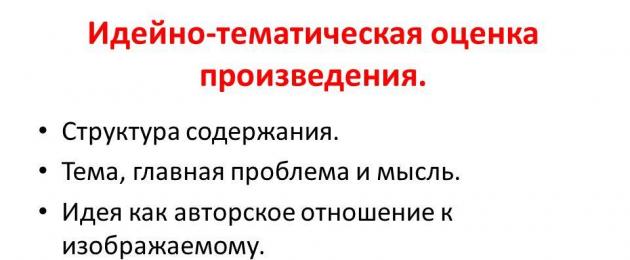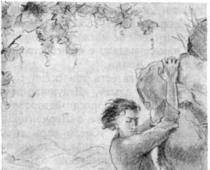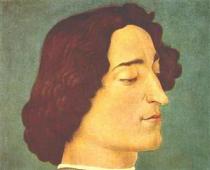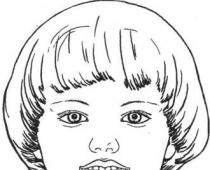
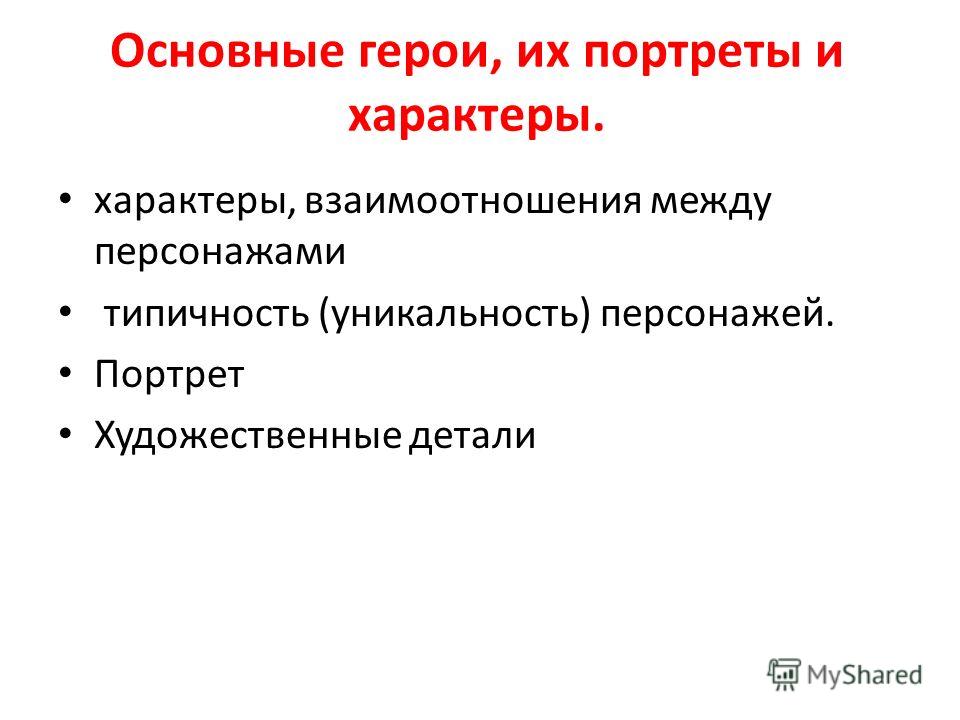
Plot specificity – Number of storylines; – exposure - conditions and circumstances that led to the conflict; – beginning - the beginning or manifestation and aggravation of the conflict; – development of action; - climax; – decoupling; - epilogue. Not all elements may be present
![]()
Composition: – sequence and interconnectedness of all parts of the work (sections, episodes, scenes, introductory episodes, lyrical digressions, paintings, images), unfolding of actions and grouping and arrangement of characters; – layout methods art world: portrait, landscape, interior, lyrical digression; – methods of depiction: story, narration, description, monologue, internal monologue, dialogue, remark, remark; – subjects’ points of view work of art: author, storyteller, narrator, characters; – whether the author adheres to a cause-and-effect relationship or not.
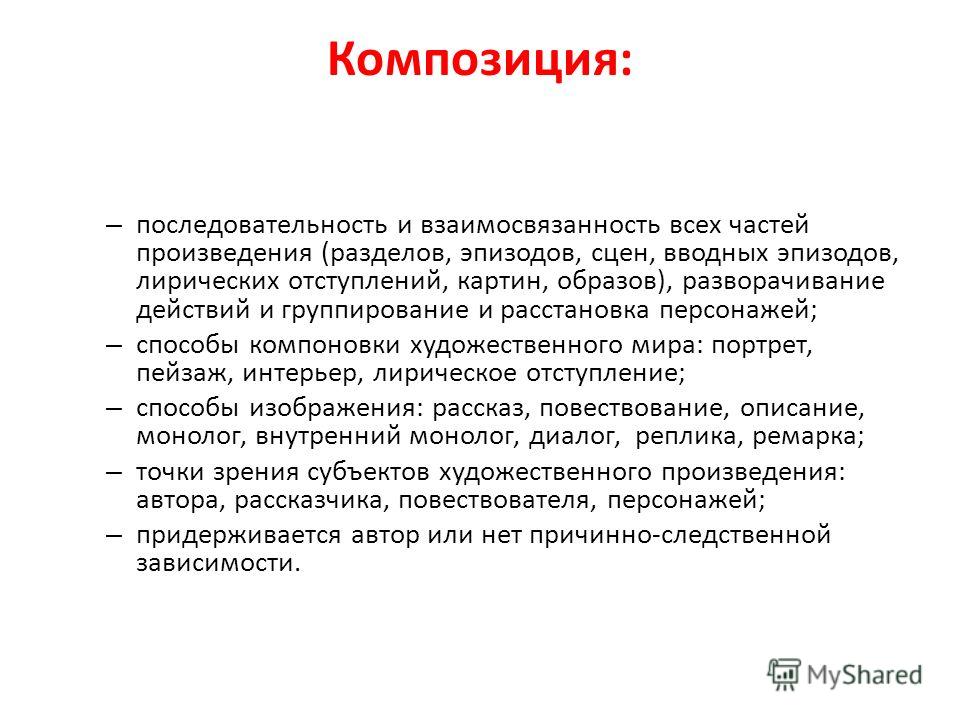

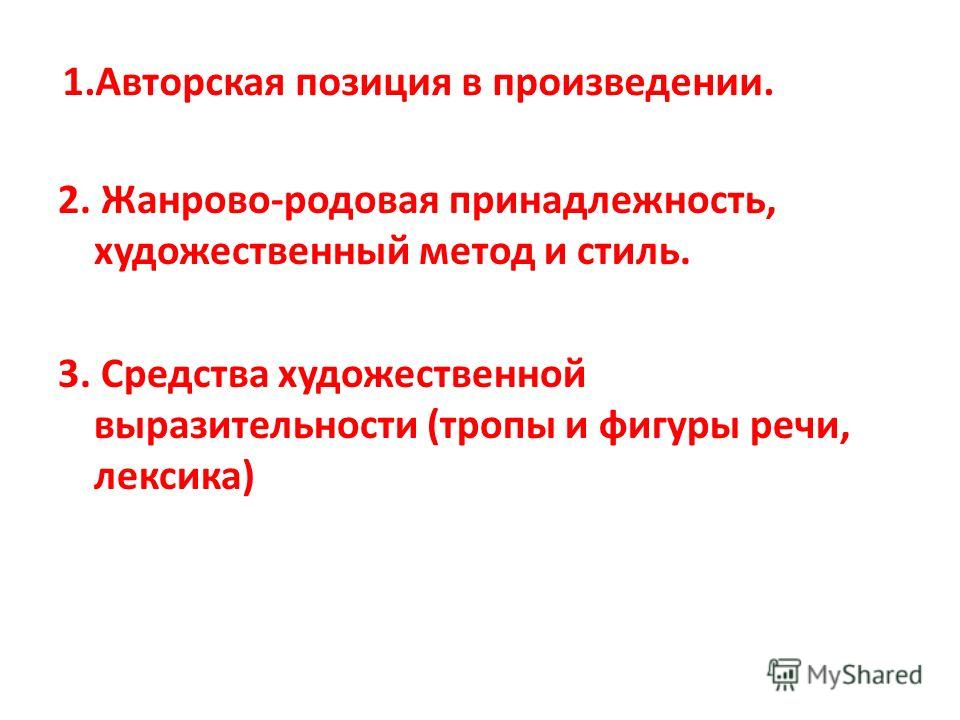
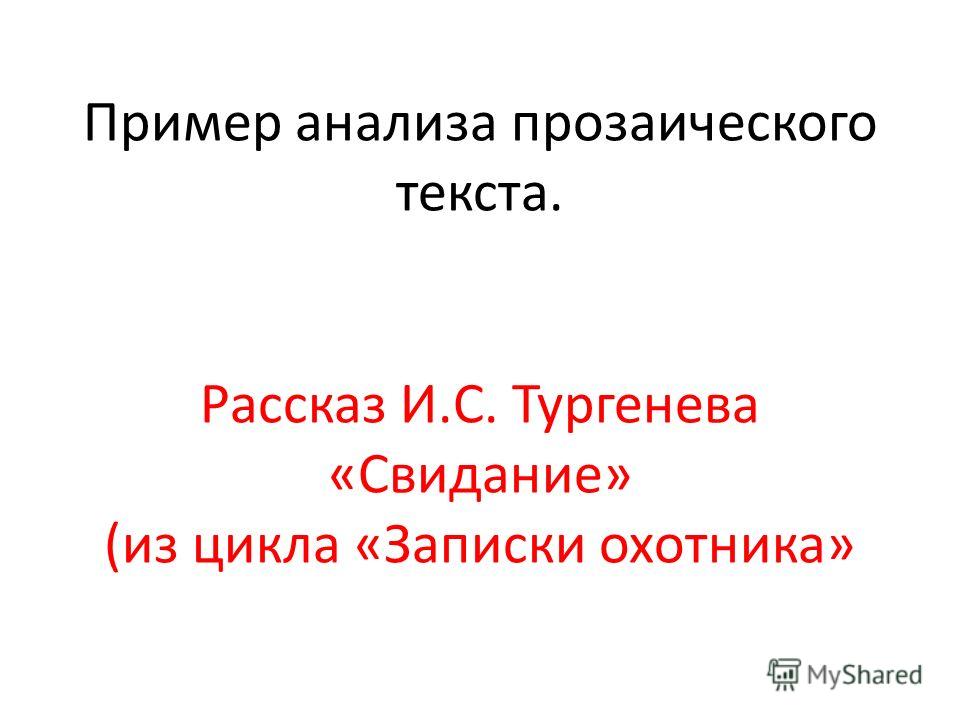
The history of creation and the place of the story in Turgenev’s work The story “Date” belongs to the cycle of stories “Notes of a Hunter”, written in different time, but united by theme, ideas, genre, style and character of the narrator. This story was first published in 1850 in the Sovremennik magazine.

Plot The plot of the story is that the narrator, while hunting, witnesses a meeting between Victor and Akulina in the forest. Victor announces his imminent departure with the young gentleman from the village. The girl feels unnecessary to her loved one, humiliated and lonely. The cruel young man is cynically indifferent to her suffering. He leaves without saying goodbye, leaving the sobbing Akulina lying face down on the grass. The appearance of the Hunter scared the girl. She quickly disappears into the thicket, leaving a bouquet of cornflowers in the clearing. The hunter carefully selects flowers and stores them.

Topics and problems. the object of the story is the denouement of the love relationship between two internally different people, their different understanding of the situation. The main motive is eternal human relationships, loyalty and frivolity, depth of feelings and superficiality. The problematic is determined by the author’s attitude to what is being described. One of the important elements of the story’s problems is the contrast between peasant farmers and servants. This theme is also heard in other stories in the series. Social conflict These two classes were reflected in this story in the personal conflict of two heroes - a peasant woman and a servant.

Plot and composition The plot of the story “Date” is built according to the classical scheme: exposition, plot, development of events, climax, denouement and epilogue. The exposition of the story invites the reader to experience the magnificent autumn landscapes of central Russia. Against the backdrop of nature, in a forest clearing, the beginning of the main storyline takes place - a meeting in spirit between the main characters. As the conversation develops, the history of their relationship becomes clear, and a conflict situation arises.
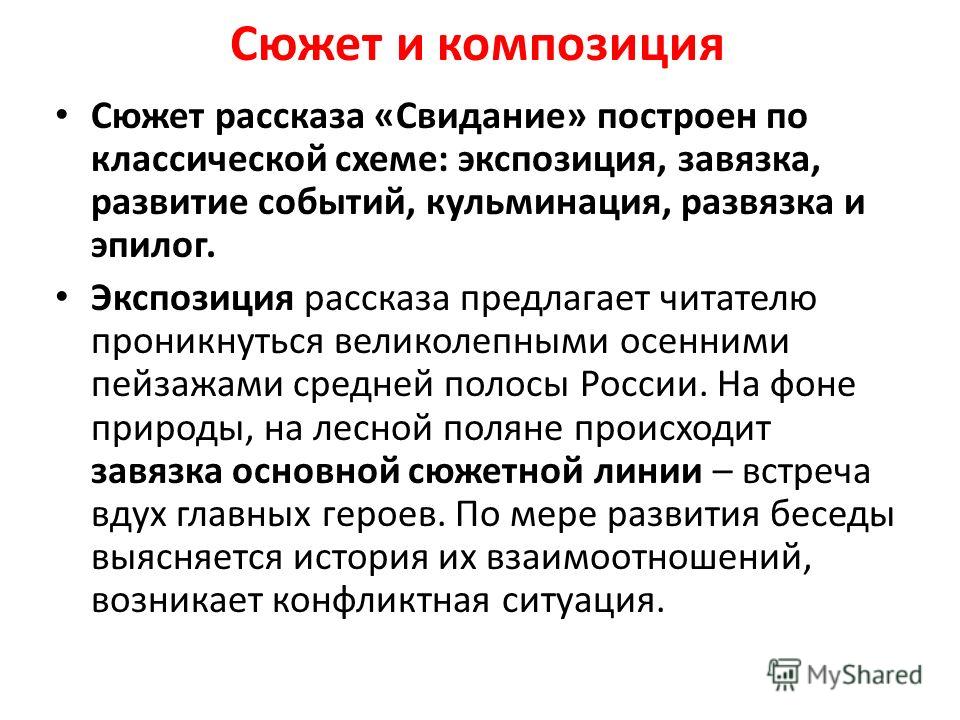
The climax is when the two characters can no longer be with each other. Emotional stress reaches its climax, and the heroes part. This storyline has an open ending, events are interrupted at the climax. But the plot of the story does not end there.

The inevitability of separation due to Victor's departure served as an impetus for the discovery of a deep conflict: one of the heroes does not, and did not previously, attach much importance to their relationship, while for the other this is their whole life; the girl completely relies on her lover, devotes herself entirely to him and probably has hopes. She doesn't allow herself to doubt that this is just as important to him. And when the obvious indifference of the young man can no longer be hidden from herself, the girl humbly asks for one thing - understanding, however, the limited and narcissistic lackey is not capable of this either.

Another side storyline is the relationship between the narrator and the girl. Strictly speaking, these relationships are more imaginary on the part of the author. The characters do not know each other and have not spoken to each other. Their meeting was accidental.. However, this meeting had a great impression on the hunter, he thought about her and remembered the girl several years later. The hunter sympathizes with the heroine of his story so much that he takes upon himself what Akulina expected from Victor - understanding and compassion.
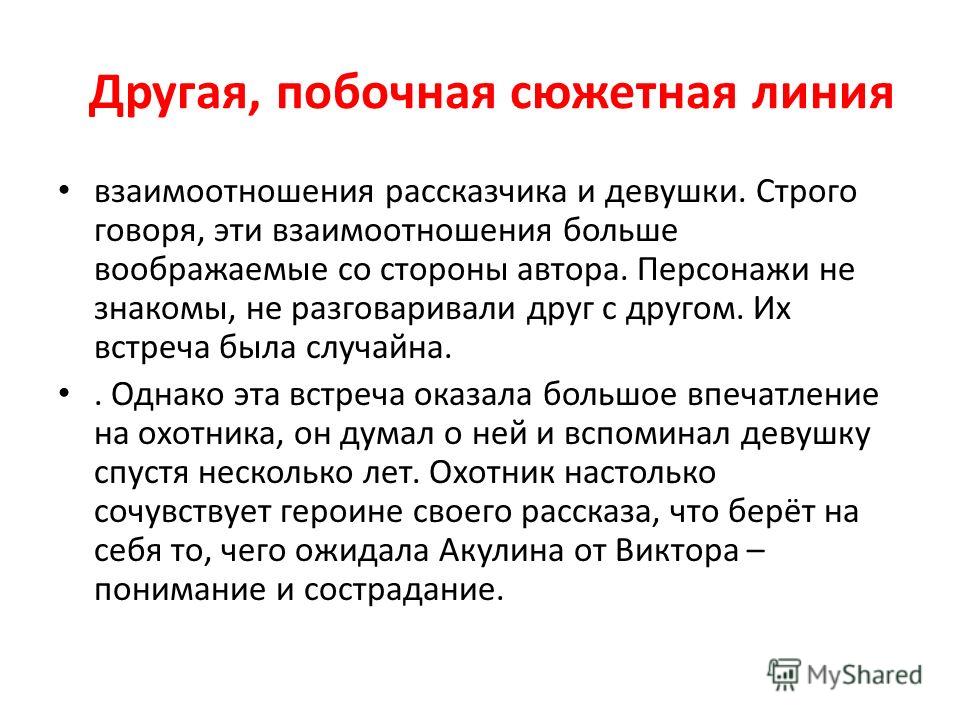
Akulina This image forms the ideological and compositional center. The author pays attention not only to the features of external appearance, but also resorts to describing facial expressions, gestures and poses. The hair is combed in a peasant style - “diverging in two semicircles from under a narrow scarlet bandage.” The skin is thin, beautifully tanned. Further mention is made of high eyebrows and long eyelashes, and the narrator’s imagination draws the girl’s eyes before he saw them. A simple peasant costume looks neat and even elegant on a girl. This is a clean white shirt, highlighting the noble color of the skin, and a plaid skirt. The only decoration is large yellow beads. "not really a man"

Victor Victor's arrival is described in dynamics. this guy doesn't make a good impression. This is “the spoiled valet of a young, rich master”, Victor’s attempts to add gloss to his suit only expose unpleasant features: collars prop up his ears, starched sleeves and especially gold and silver rings draw attention to the ugly red crooked fingers; tiny, milky-gray eyes, instead of mustaches - disgusting yellow hairs on my thick upper lip. The face is ruddy, fresh, impudent, with a very narrow forehead (thick, tightly curled hair, starting “almost at the very eyebrows.” The character pronounces words casually, somewhat nasally

Hunter In the story, he is the narrator, a witness to the events, and at the same time the judge of what is being described, giving an assessment and partially drawing conclusions. observant, witty, critical thinking person, by social status a landowner; Not only is he passionate about hunting, but he appreciates and knows nature and, most importantly, is interested in the lives of the people he meets. The hunter tries to pay attention to the character of everyone, regardless of class, but taking into account the living conditions of his heroes.
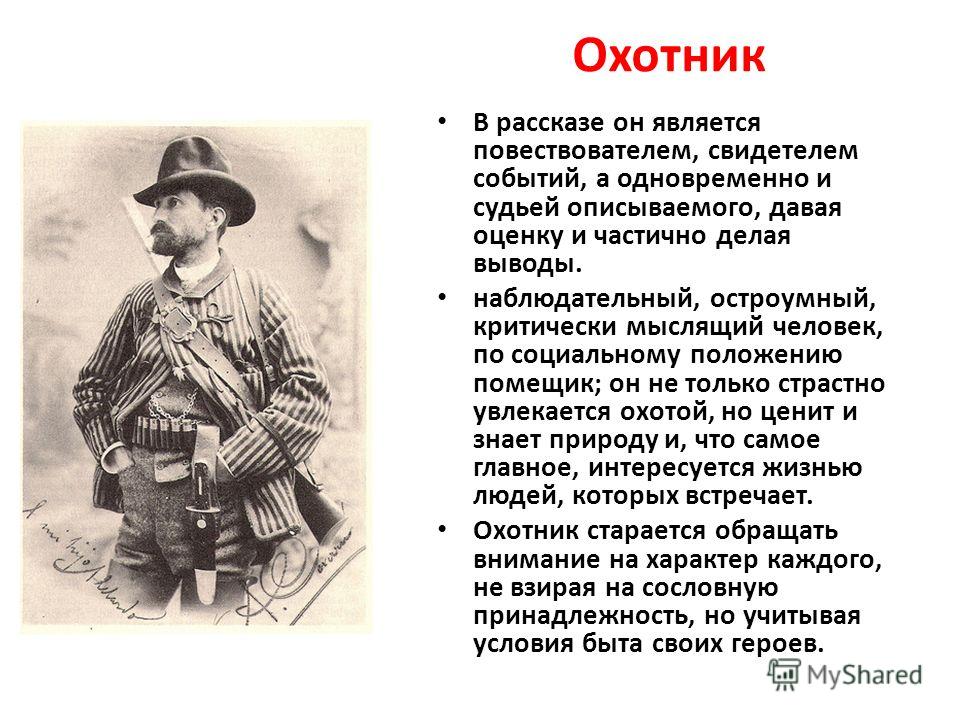
The speech of the characters The narrator's monologue is interspersed with dialogues; deviations from the plot express the author's attitude towards what is being described. In direct speech, the characteristics of the speaker are preserved, determining social affiliation and occupation. Akulina’s speech is smooth, euphonious, full of epithets, but at the same time simple and quite literate. She fits the image of a “shepherdess,” a somewhat idealized peasant woman. Victor’s speech reveals his belonging to the gentry. There is a touch of artificiality in it: a slightly awkward syntax (“wants to join the service” - a characteristically inappropriate reverse order words), abruptness, excessive introductory words (“so to speak”), the presence of stylistically inappropriate vocabulary (education), also distorted (“sociality”). The narrator speaks in the first person. By the colorful descriptions of nature, one can distinguish an inveterate hunter, and the apt characteristics of the characters and the selection of artistic details reveal an observant and experienced psychologist. The speech is distinguished by its artistry and richness of vocabulary.

Artistic details Bouquet This is a very important symbol for the entire work. each element of the bouquet has its own meaning. If we consider the color scheme, then variegated yellow, white, purple flowers serve as a frame for larger dark cornflowers, carefully prepared in advance for a loved one, rejected by him and selected and saved by the narrator. In an allegorical sense, these are all the best feelings and thoughts dedicated by the girl to her chosen one, also scolded, but striking a casual eyewitness and sketched by him on the pages of his notes.
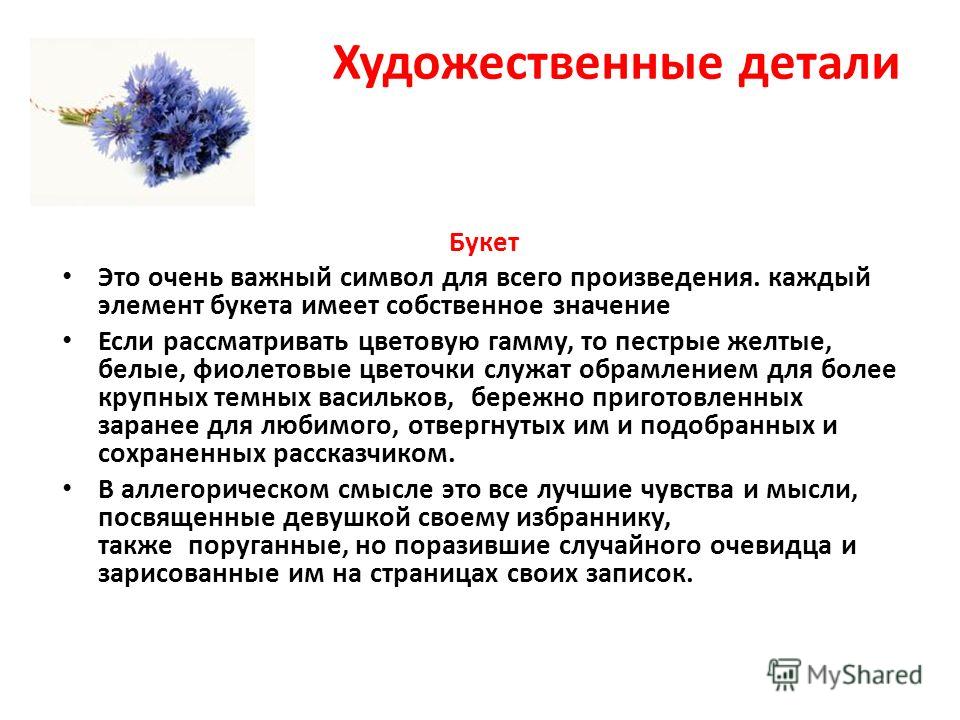
Lornette is an attribute of Victor, another character unsympathetic to the narrator. In a natural interior, everyday life ordinary people, this item stands out as inappropriate, useless. Also, his master, the footman, is discordant with the surroundings with his appearance, manners and useless role in life.

Landscape The time of year - autumn - traditionally symbolizes the final phase in literature. In the context of the plot, this is the end of the relationship between the two main characters. the mood of autumn - decline, sadness, anxiety - corresponds to the mood of the events described in the story. The contrast between the aspen and birch groves corresponds to the contrast between the characters of the main characters. The narrator’s sympathy for the girl’s character is projected onto the preference given to the birch tree, admiring this tree. At the same time, hostility towards Victor is reflected in the attitude towards aspen

What does the teacher want from the student when he demands comprehensive analysis text? The plan for such a task includes several points, which we will consider in this article. The work must take into account the historical realities in which the work was created, the characters and roles of the characters (both main and secondary), features of the language and the structure of the text.
Context
The author of the work you are researching is an ordinary person existing in some historical period time. Problems in public life, political tension, and personal experiences leave an indelible imprint on the works he publishes. Research what factors contributed to the writing of the book, and if you can, find parallels between the storylines and real world events. All this will form the first point of the plan for analyzing a text in literature.
Often the relationships between the characters unfold against the backdrop of major domestic and foreign political events: civil and international wars, revolutions, riots and uprisings, and the adoption of high-profile legislative acts. Sometimes the text reflects natural phenomena: drought and subsequent famine, eclipses, which are attributed with symbolic meaning, flooding of territories.
main idea
Highlight main idea works. What is the message that the author wants to convey to the reader? What theme is the story built around? Point out how the writer sets the stage for the content section.
 When composing the text, pay attention to keywords that often appear in the work. Based on them, you can easily highlight storylines, pressing and controversial issues. Plus, it will make your task easier. “Finding words” is often the most difficult thing when you understand the meaning, but cannot convey it through language. This skill only comes with experience.
When composing the text, pay attention to keywords that often appear in the work. Based on them, you can easily highlight storylines, pressing and controversial issues. Plus, it will make your task easier. “Finding words” is often the most difficult thing when you understand the meaning, but cannot convey it through language. This skill only comes with experience.
Types of speech
What stylistic means does the author use to express his thoughts? Perhaps he uses a narrative type of speech: you follow the actions of the characters, the process of their communication in different environments. At times, the focus of attention switches to “scenery” and forms - the writer clarifies details, uses descriptions of objects in order to create a more realistic picture, literally “draws” in the imagination of a person holding a book in his hands.

The most difficult type to analyze is an argument in which arguments are presented and a certain point of view of the author is defended, which may be different from yours. Writing a paper on this type of work can be a real challenge if you fundamentally disagree with the arguments presented. And choosing your arguments can sometimes be very difficult.
Style
The conversational style is usually used when describing the communication of characters. If the characters belong to the uneducated population, the peasantry, etc., then the author can even use reduced and rude language; if aristocrats or representatives of other “higher circles” communicate, then according to the text they often use overly lofty words. This is worth noting during a comprehensive text analysis (the plan includes an analysis of the styles used).
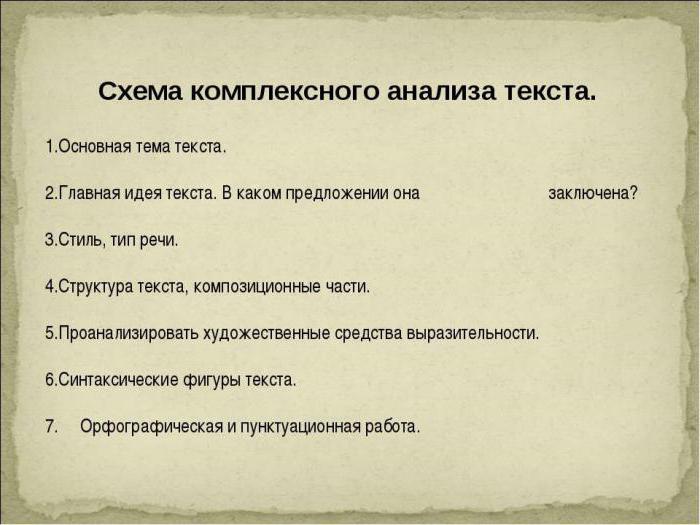
The text may also include an artistic or journalistic style - the language of newspapers, magazines and other periodicals. There is also a type of speech used in the preparation of documents and other business papers. This style is called formal business style.
Hero behavior
Observe what the characters do and say. What is their function? Why were they introduced by the writer into the course of the narrative, included in the author’s plan? Analysis of a literary text cannot do without evaluating their activities. "What is good and what is bad?" - this is, of course, a very controversial issue. However, it is your responsibility as a researcher to at least try to answer it using arguments and examples from the book.
Author's features
Note what turns of phrase, artistic and stylistic structures distinguish the works of the selected writer from many others? Which lexical units does he use more often than others? What can you say about the author's morphology, syntax, phonetics? Such details ultimately create a complete portrait of a literary classic.
Artistic media
What structures can you see in the text? Which ones are used more often than others? This point should under no circumstances be omitted in terms of analyzing prose text. Your teacher has taught you about this topic and will be happy to see you apply what you have learned.
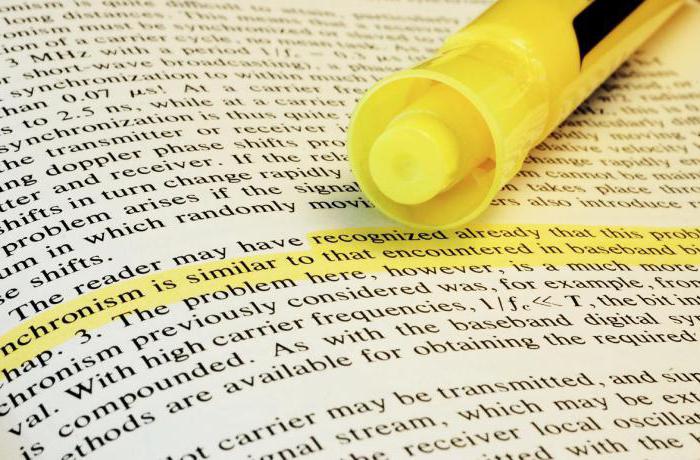
Perhaps the author often uses irony or makes sarcastic attacks on characters? This is typical for many writers. The works of Bernard Shaw or Mark Twain are especially notable for the abundance of such elements. Russian writers also loved to joke: Pushkin, Gogol, and even Mayakovsky - after reading their works, you will certainly see what they are talking about.
On the other hand, the text may be replete with epithets, metaphors, hyperboles and litotes - all these terms you should know from literature lessons. All these tools are often used, for example, when describing nature or assessing the actions and characters of others by some characters.
The text analysis plan should also include a careful analysis of the phonotactic component and rhythm if you are working with a work written in poetic form. Poems, epigrams, ballads, songs - each of these genres has features that must be clearly highlighted. Otherwise, the teacher will lower your grade.
Achievements
Moving on to the conclusion of the work, in the last paragraph of the text analysis plan, plan to study what trace your chosen work has left in history. Perhaps we should talk not only about a specific work, but also about the writer: which of his works can be mentioned along with the one being analyzed?

What is the importance of his work then, in the past, and now? Not a single work is included in the course of literature lessons by chance. Try to expand on this topic.
Conclusion
So, the text analysis plan discussed in this article consists of almost ten points, each of which should be covered in your work.
If you do everything in accordance with the recommendations provided, the teacher will be pleased and will give you an excellent grade. Of course, a lot depends on the depth and quality of your reasoning and argumentation, but the very presence of a structure that addresses all issues of interest to the teacher will add an extra point to your grade.
At the Literature Olympiad ( regional stage) there will be 2 options for tasks. Option 1 - comprehensive analysis of prose text, option 2 - comparative analysis poems
Analysis of a lyric poem
The method of analysis is dictated by the ideological and artistic features of the work, taking into account the intuitive-irrational, poetic comprehension and theoretical-logical principles. Exist general principles scientific analysis of poetic works, based on the typological properties of genres, types of lyrical compositions, etc. The analysis should not be random, fragmentary, and should not be reduced to a simple transfer of impressions or retelling.
Analysis of a lyric poem reveals correspondences between the distribution of grammatical categories and metric, strophic correlations, and semantics of the text. Below is an approximate diagram of a holistic (multidimensional) analysis of a lyric poem in the unity of its formal and substantive aspects (in accordance with poetic world and the author’s artistic system).
Parsing scheme
Extratextual connections
Creative history of the work (date of writing, textual criticism); the place of the poem in the creative evolution of the poet; historical, literary, everyday context; real-biographical commentary, history of critical assessments.
Ideological content.
Thematic structure. Motivation. Leitmotifs.
Type of lyric poem (meditative, meditative-figurative, visual lyrics).
Specificity of the genre form (elegy, ballad, sonnet, epistle, etc.).
Pathos.
The semantics of the title, its connection with the main poetic idea.
Construction (structure) of a verse
Architectonics.
Composition. Repetitions, contrasts, oppositions. Types of composition. The ending. Comparison and development of basic verbal images (by similarity, by contrast, by association, by inference).
Morphological aspect of the poetic model. Distribution of grammatical categories, parts of speech.
Lyrical hero. Speech subject and addressee of lyrics.
Forms of speech communication (dialogue, monologue).
Poetic vocabulary.
Rhythm and metric.
Phonics. Sound (phonological) structure (alliteration, assonance, sound repetition, paronymic attraction and other types of sound instrumentation). Euphony (euphony).
In the scheme for analyzing a lyric poem proposed below, the sequence of points is not strictly observed; the main requirement is to take into account (if possible) all of the specified components.
An important aspect when studying literary work What remains is the determination of the analysis methodology and methods of its interpretation. Modern philological research creatively uses and complements each other the methodologies of different scientific systems, each of which is significant in its own way in the history of critical thought.
Samples of 1) holistic (system); 2) formal; 3) structural-semiotic and 4) linguistic-poetic analyzes of poems, see the literature below:
1) Muryanov M.F. Questions of interpretation of anthological lyrics (Pushkin’s poem “The fire of desire burns in the blood”) // Analysis of a literary work. L., 1976. P.173-212; Analysis of one poem. L., 1985; Girshman M.M. Rhythmic composition and stylistic originality of poetic works // Girshman M.M. Literary work: Theory of artistic integrity. M., 2002, pp. 215-247; Broitman S.N. Secret poetics of A.S. Pushkin. Tver. 2002. P.13-43 (see: A. Pushkin “On the hills of Georgia lies the darkness of the night”, “For the shores of a distant fatherland”, “What is in my name for you?”).
2) Jacobson R. Pushkin’s poems about the virgin-statue, the bacchante and the humble woman; About “poems composed at night during insomnia”, The texture of one quatrain of Pushkin // Jacobson R. Works on poetics. M., 1987. S. 181-197; P.198-205; P.210-212.
3) Lotman Yu. M. Analysis of poetic text. L., 1972. P.133-270; Ivanov Vyach. Sun. The structure of Khlebnikov’s poem “They carry me on elephants” // Russian Literature. From the theory of literature to text structure: An Anthology. M., 1997. P.245-257; Levin Yu.I. O. Mandelstam. Analysis of six poems; B. Pasternak. Analysis of three poems; A.S. Pushkin. “To the portrait of Zhukovsky”; G. Ivanov “It’s good that there is no tsar...” // Levin Yu.I. Selected works. Poetics. Semiotics. M., 1998. P.9-51; pp.156-174; pp. 267-270; pp. 271-275; Taranovsky K. Essays on the poetry of O. Mandelstam // Taranovsky K. About poetry and poetics. M., 2000; Lotman M. On the death of Zhukov // How Brodsky’s poem works. Sat. Art. M., 2002. P. 64 -76.
4) Fateeva N.A. “When streams sing romances almost in human words” // Language as creativity. M., 1996. P.170-189; Shestakova L.L. Linguistic techniques for forming text in the poetry of E. Baratynsky (based on the material of “Disbelief” // Language as creativity. M., 1996. P. 118-125; Shestakova L.L. Osip Mandelstam. “Sisters of heaviness and tenderness, your signs are the same” // Russian language at school. 2000. No. 2. P.69-75.
2. Analysis of prose text
The scheme for a comprehensive philological analysis of a text (prose, first of all) includes the following stages: a generalizing characteristic of the ideological and aesthetic content, determining the genre of the work, characterizing the architectonics of the text, considering the structure of the narrative, analyzing the spatio-temporal organization of the work, the system of images and poetic language, identifying elements of intertext .
Parsing scheme
Introduction. Creative history (textual criticism), the history of critical assessments, the place of a work (story, essay, tale, short story) in the creative evolution or artistic system of the writer, in the history of the literary process.
Problem-thematic aspect.
Text analysis.
Semantics (symbolism) of the name. The breadth of the semantic area through the prism of the title.
Architectonics.
Spatio-temporal organization of the artistic world: the image of time and space (“chronotope”, space-time continuum, relationship between the character and the scene). Spatial and temporal oppositions (up/down, far/close, day/night, etc.).
Composition. Compositional techniques (repetition, editing, etc.). The reference “points” of the composition.
Plot. Meta-descriptive snippets.
Rhythm, tempo, tone, intonation of the story.
Functional and semantic types of speech (description, narration, reasoning).
Stylish originality. System of visual aids.
System of images. Speech of heroes.
Portrait.
Artistic detail (external, psychological, symbolic detail). Functional detail. Detail.
Scenery. Interior. The world of things. Zoologisms.
The role of subtext and intertextual connections.
Analysis of a literary work. L., 1976.
Girshman M.M. Rhythmic composition and stylistic originality of prose works (“After the Ball”, “The Death of Ivan Ilyich” by L.N. Tolstoy; “The Meek” by F.M. Dostoevsky; “Student” by A.P. Chekhov), etc. // Girshman M. M. Literary work: Theory of artistic integrity. M., 2002, pp. 314-407.
Esaulov I. A. Spectrum of adequacy in the interpretation of a literary work (“Mirgorod” by N. V. Gogol). M., 1995.
Nikolina N.A. Philological analysis of the text. M., 2003 (aspect analysis of the text - “Other Shores” by V. Nabokov: genre originality of the text; “Bezhin Meadow” by I.S. Turgenev: figurative structure of the text; I.A. Bunin’s story “Cold Autumn”: conceptualization of time; “ Sun of the Dead» I.S. Shmeleva: key words in the structure of the text; Intertextual connections of T. Tolstoy’s story “If you love, you don’t love”; complex analysis of prose text – Story by I.A. Bunin "Mr. from San Francisco").
Shcheglov Yu.K. Poetics of Chekhov (“Anna on the Neck”) // Zholkovsky A.K., Shcheglov Yu.K. Works on the poetics of expressiveness: Invariants – Theme – Techniques – Text. M., 1996. pp. 157-189.
Yablokov E.A. Text and subtext in the stories of M. Bulgakov (“Notes of a Young Doctor”). Tver, 2002.
Comparative analysis of the poems by M. Yu. Lermontov “Cross on the Rock” and A. S. Pushkin “Monastery on Kazbek”
Cross on the rock
(Mlle Souchkoff)
In the gorge of the Caucasus I know a rock,
Only a steppe eagle can fly there,
But the wooden cross turns black over her,
It rots and bends from storms and rains.
And many years have passed without a trace
Since it is visible from the distant hills.
And each hand is raised up,
It's like he wants to grab the clouds.
Oh, if only I could get there,
How I would have prayed and cried then;
And then I would throw off the chain of being
And with a storm I would call myself brother!
MONASTERY ON KAZBEK
High above the seven mountains,
Kazbek, your royal tent
Shines with eternal rays.
Your monastery is behind the clouds,
Like an ark flying in the sky,
Hovering, barely visible, above the mountains.
A distant, longed-for shore!
There I would say, forgive me, by the gorge,
Rise to the free heights!
There, in the sky-high cell,
I should hide in God’s neighborhood!..
It would be tempting to assume that M.Yu. Lermontov was familiar with the text of the poem “Monastery on Kazbek” (1829). Then one could write about the polemical response of a daring teenager to a great contemporary. But, most likely, a number of coincidences at different levels, which we will record during a comparative analysis, are due to the specifics of the romantic method with which both works were written.
The commonality is noticeable even at the first glance at the titles of the poems. The initial lines of texts are immediately set general theme and color. (Caucasus). It is clear that in both authors the lyrical heroes are at the foot (cliffs, mountains), and their views and thoughts are directed upward. Thus, the very location of the heroes sets the romantic antithesis of “here” and “there”. The poem by A. S. Pushkin was created at a time when the poet himself regularly declared his departure from the romantic method. For example, in one of his private letters he comments in detail on the progress of the creation of “ winter morning”, published in the same 1829, explains why all the editing went from the “Cherkasy horse” to the “brown filly”, that is, to a more “prosaic” figurative system, vocabulary, syntax, and so on.
Fortunately, the time when we tried to straighten things out is a thing of the past. creative path any author and looked for evidence that all great poets moved “from romanticism to realism.” The implication was that the realistic method was, of course, better.
The Caucasus awakened and awakens a romantic worldview for almost all Russian lyricists and in any of their “creative periods.”
Pushkin's lyrical hero standing at the foot high mountain, looks at the top of Kazbek and reflects on eternity, about God, about freedom...
In M. Yu. Lermontov’s poem “The Cross on the Rock” (1830), the lyrical hero is also shocked by the Caucasian landscape, but his thoughts and feelings are completely different. The named work of M. Yu. Lermontov, like many other poems of 1830, is dedicated to E. A. Sushkova, (later Countess Rostopchina.) It should be noted that this woman was a poetess, so Lermontov addressed not only poems to her love theme, but hoped that his girlfriend would share and understand the thoughts and moods that his lyrical hero experienced.
Images of rocks, cliffs, and mountains run through all of Lermontov’s work; this author has repeatedly declared his love for the Caucasus mountains. But the young poet’s love for nature, like his love for a woman, is gloomy and hysterical.
The lyrical hero of the “early” Lermontov calls his “familiar” and favorite place in the Caucasus a rock, on top of which there is someone’s unmarked grave with a simple wooden cross on it. The cross has turned black and almost rotted from the rains, but 6 out of 12 lines of text are devoted to the description of this particular gloomy detail of the landscape.
This poem is very simple in “form”: it is written in amphibrachium tetrameter with a caesura, consists of three quatrains with adjacent rhymes, and the rhymes are precise and banal. The work is divided into two parts: two quatrains are a description of the cross on the rock, the last four verses are an emotional response.
In the first lines, the eagle, beloved by romantics, appears, which - fortunately for him - can fly so high that he rests on the top of a rock. The lyrical hero languishes because he cannot climb the rock, and the personified cross, resembling a man from below, stretches even higher, as if “he wants to grab the clouds.” Thus, one direction of movement runs through the entire poem: from below to upward. The work contains two contrasting color spots: a black cross and white, unattainable clouds.
The last quatrain is one exclamatory sentence, almost entirely consisting of romantic cliches and beginning, of course, with “Oh!”
The hero rushes “there”, “up”, there he will “pray and cry”, because, probably, from here, below, God does not hear his groans. The young romantic wants to “throw off the chain of being,” get rid of his shackles and fraternize with the storm (it’s worth remembering Mtsyri).
The last quatrain was written in subjunctive mood and the repeated “would”, together with the words “dropped”, “being”, “with the storm”, “brother” give a sonorous alliteration.
Overall, this poem seems weaker to me than “The Sail” or “The Beggar,” written around the same time. The paradox is that, although the analyzed text is imitative in nature, it is, at the same time, very characteristic of the attitude of early Lermontov and his style, which, according to E. Maimin, was “the standard of romanticism.”
Pushkin's poem creates a completely different mood in the reader. Yes, the lyrical hero also dreams of getting “there”, to the top of the mountain, where the ancient Georgian church is located. But he strives not for storms, but for peace. The top of Kazbek “shines with eternal rays,” and light clouds are needed only so that not everyone can see the protected place. The sky, like the sea, is a free element for Pushkin, which is why it is so natural to compare a barely visible church with a “flying ark” in which only the elect must be saved.
Pushkin’s work is also divided into two parts, corresponding to two stanzas, but the second stanza consists of five lines, which obviously, by the rhyming system itself, puts one of the lines in a “strong position.” Here is the exclamation: “The distant, longed-for shore!” The image of the desired and unattainable shore (and even more solemnly - the archaic, eternal “shore”) is also quite logical after the description of the symbol ship. Pushkin’s lyrical hero does not look for storms; for him, happiness is “peace and freedom.” He strives for the “transcendental cell,” and it is in solitude that he hopes to find freedom, for it is within the soul, and not granted from the outside.
It is no coincidence that the lyrical hero dreams of “the neighborhood of God.” He does not ask the Almighty for anything, he himself is almost equal to him.
The entire poem is written in traditional iambic tetrameter, with a large number of pyrrhics to lighten the verse. In the first stanza, adjacent rhyme subtly divides the sextine into couplets. But the very first line of the five-line rhyme is connected with the first part, and the remaining four verses are rhymed “crosswise”. All this, as we have already noted, highlights the key line - the impulse of the spirit to the distant, illuminated by rays, divine “shore”.
In the second stanza, Pushkin, like Lermontov, concentrates the maximum of emotions. The quintet of Pushkin’s text consists of three exclamatory sentences, two of which begin with a romantic impulse: “There b...!” This striving from the gorge to the top is recognized by the lyrical hero as a natural impulse of the spirit. The unattainability of this dream is also natural. Pushkin's poem is bright and wise, without youthful anguish and pain.
Thus, a comparison of two “Caucasian” works by Pushkin and Lermontov once again emphasizes the difference in both the worldviews and idiostyles of these Russian classics.
"MONUMENT" BY G. R. DERZHAVIN AND "MONUMENT" BY V. Y. BRYUSOV
(methodological aspect of comparative analysis)
Theme of the monument, methodological aspect, comparative analysis, poetics, figurative system
The theme of the monument occupies a large place in the works of Russian poets, so this topic is given considerable attention in school programs. Comparative analysis of poems by G.R. Derzhavin and V. Ya. Bryusov will help students understand the originality of the solution to the theme of the monument in the work of the poet of the 18th and 20th centuries, and reveal the individuality of the artists’ style and worldview.
These two poems are based on one theme, one source - Horace's ode "Monument". The poems of G. R. Derzhavin and V. Ya. Bryusov can hardly be called translations of Horace’s ode in the exact sense - they are rather a free imitation or alteration of the latter, which allows literary scholars to consider these works as independent and original.
Derzhavin's poem "Monument" was first published in 1795 under the title "To the Muse. Imitation of Horace." Bryusov's "Monument" was written in 1912. The teacher asks students to read poems, compare them and answer the questions:
What exactly did each poet recognize in his work as deserving of immortality?
Compare the figurative structure of the poems, rhythmic organization, stanza, syntax. How does this affect the overall pathos of the poems?
What is unique about the lyrical hero of the poems?
Pay attention to geographical names. How do they define the space of poems? Derzhavin sees his merits in the following:
That I was the first to dare in a funny Russian syllable
To proclaim Felitsa’s virtues,
Talk about God in simplicity of heart
And speak the truth to kings with a smile.
Students comment that the poet made the Russian style simple, sharp, and cheerful. He “dared” to write not about greatness, not about exploits, but about the virtues of the empress, seeing in her ordinary person. The poet managed to preserve human dignity, sincerity, and truthfulness.
Bryusov speaks about his merits in the fourth stanza:
I thought for many, I knew the pangs of passion for everyone,
But it will become clear to everyone that this song is about them,
And distant dreams in invincible power
Each verse will be proudly glorified.
According to the author, he managed to convey human thoughts and passions in the “singing” words of his creations.
The poems of Derzhavin and Bryusov are similar not only thematically, but also in the external features of their construction: both are written in four-line stanzas (Derzhavin has 5 stanzas, Bryusov has 6) with male and female rhymes alternating in all stanzas according to the pattern: awav. The meter of both poems is iambic. Derzhavin has iambic hexameter in all lines, Bryusov has iambic hexameter in the first three lines and tetrameter in the fourth line of each stanza.
Students note the difference at the syntactic level. Bryusov’s poem is complicated not only by exclamatory forms, but also by rhetorical questions, which gives the intonation some expressiveness and tension.
In Derzhavin’s poem, the image of the lyrical hero connects all the stanzas, only in the last does the image of the muse appear, to whom the hero turns with the thought of immortality. In Bryusov, already in the first stanza, the image of the lyrical hero is contrasted with those who did not understand the poet - the “crowd”: “My monument stands, composed of consonant stanzas. / Shout, go wild, you won’t topple it!” This opposition gives rise to the tragic attitude of the lyrical hero.
It is interesting to compare the spatial plans of the poems. From Derzhavin: “Rumor will spread about me from the White Waters to the Black Waters, / Where the Volga, Don, Neva, and the Ural flows from Riphean;..”. Bryusov writes that his pages will fly: “To the gardens of Ukraine, to the noise and bright dream of the capital / To the threshold of India, to the banks of the Irtysh.” In the fifth stanza, the geography of the verse is enriched with new countries:
And, in new sounds, the call will penetrate beyond
Sad homeland, both German and French
They will humbly repeat my orphaned poem,
A gift from supportive muses.
Students come to the conclusion that the space of the symbolist’s poem is much wider: it is not only the expanses of Russia, but also European countries- Germany, France. The symbolist poet is characterized by exaggeration of the theme of the monument, the scale of influence of both his own poetry and poetry in general.
The next stage of the work may be associated with a comparison of the visual and expressive means used by the classicist poet and the symbolist poet. Students write epithets, comparisons, metaphors in their notebooks, generalize examples and draw conclusions. They note the dominance of Derzhavin’s epithets: “wonderful, eternal monument”, “fleeting whirlwind”, “countless peoples”, “just merit”, etc., as well as the use of inversion, which gives solemnity, clarity, and objectivity to the image. In Bryusov, metaphors play a significant role in the poem: “the decay of melodious words,” “a gift from supportive muses,” etc., which seems to emphasize the scale of the style and the tendency to generalizations. In the poem of the classicist poet, the image of the empress and the theme of power associated with her are natural. The symbolist is not interested in images of statesmen, kings, and generals. Bryusov shows the inconsistency of the real world. His poem contrasts the “poor man’s closet” and the “king’s palace,” which introduces a tragic element into the work of the symbolist poet.
The teacher can draw students' attention to vocabulary, sound and color writing of poems. Finding commonalities and differences, students come to the conclusion about the continuity of traditions in Russian literature and the diversity and richness of styles, methods, and trends.
The leading principle of Bryusov's poetry is thought. The vocabulary of his poems is sonorous, close to oratorical speech. The verse is compressed, strong, “with developed muscles” /D. Maksimov/. Thought also dominates in the poem of the classicist poet, whose style is characterized by rhetoric, solemnity, and monumentality. And at the same time, the work of each of them has something of its own, unique.
This form of work helps to increase the level of perception of the lyrics of Derzhavin and Bryusov, complex and the subtlest images poetry, allows you to form and consolidate students’ ideas about the theory and practice of classicism and symbolism.
1. Analysis of a work of art
1. Determine the theme and idea / main idea/ of this work; the issues raised in it; the pathos with which the work is written;
2. Show the relationship between plot and composition;
3. Consider the subjective organization of the work /the artistic image of a person, techniques for creating a character, types of image-characters, a system of image-characters/;
5. Determine the features of the functioning of figurative and expressive means of language in a given work of literature;
6. Determine the features of the genre of the work and the style of the writer.
Note: using this scheme, you can write an essay review about a book you have read, while also presenting in your work:
1. Emotional-evaluative attitude towards what you read.
2. A detailed justification for an independent assessment of the characters of the characters in the work, their actions and experiences.
3. Detailed justification of the conclusions.
2. Analysis of a prose literary work
When starting to analyze a work of art, first of all, it is necessary to pay attention to the specific historical context of the work during the period of creation of this work of art. It is necessary to distinguish between the concepts of historical and historical-literary situation, in the latter case we mean
Literary trends of the era;
The place of this work among the works of other authors written during this period;
Creative history of the work;
Evaluation of the work in criticism;
The originality of the perception of this work by the writer’s contemporaries;
Evaluation of the work in the context of modern reading;
Next, we should turn to the question of the ideological and artistic unity of the work, its content and form (at the same time, the plan of content is considered - what the author wanted to say and the plan of expression - how he managed to do it).
Conceptual level of a work of art
(theme, issues, conflict and pathos)
Theme is what it's about we're talking about in a work, the main problem posed and considered by the author in the work, which unites the content into a single whole; These are those typical phenomena and events of real life that are reflected in the work. Is the topic in tune with the main issues of its time? Is the title related to the topic? Each phenomenon of life is a separate topic; a set of themes - the theme of the work.
A problem is that side of life that particularly interests the writer. One and the same problem can serve as the basis for posing different problems (the topic of serfdom - the problem of the internal unfreedom of the serf, the problem of mutual corruption, deformation of both serfs and serf-owners, the problem of social injustice...). Issues - a list of problems raised in the work. (They may be additional and subordinate to the main problem.)
Pathos is the writer’s emotional and evaluative attitude towards what is being told, characterized by great strength of feelings (maybe affirming, denying, justifying, elevating...).
Level of organization of the work as an artistic whole
Composition - the construction of a literary work; combines parts of a work into one whole.
Basic means of composition:
Plot is what happens in a story; system of main events and conflicts.
Conflict is a clash of characters and circumstances, views and principles of life, which forms the basis of action. Conflict can occur between an individual and society, between characters. In the hero's mind it can be obvious and hidden. Plot elements reflect the stages of conflict development;
Prologue is a kind of introduction to a work, which narrates the events of the past, it emotionally prepares the reader for perception (rare);
Exposition - introduction to action, depiction of the conditions and circumstances preceding the immediate start of actions (can be expanded or not, integral and “broken”; can be located not only at the beginning, but also in the middle, end of the work); introduces the characters of the work, the setting, time and circumstances of the action;
The plot is the beginning of the plot; the event from which the conflict begins, subsequent events develop.
The development of action is a system of events that follow from the plot; as the action progresses, as a rule, the conflict intensifies, and the contradictions appear more and more clearly and sharply;
The climax is the moment of the highest tension of the action, the pinnacle of the conflict, the climax represents the main problem of the work and the characters of the characters very clearly, after which the action weakens.
Resolution is a solution to the depicted conflict or an indication of possible ways to resolve it. The final moment in the development of the action of a work of art. As a rule, it either resolves the conflict or demonstrates its fundamental unsolvability.
Epilogue is the final part of the work, which indicates the direction of further development of events and the destinies of the heroes (sometimes an assessment is given of what is depicted); This short story about what happened to the characters in the work after the end of the main plot action.
The plot can be presented:
In direct chronological sequence of events;
With retreats into the past - a retrospective - and “excursions” into
Future;
In a deliberately changed sequence (see artistic time in the work).
Non-plot elements are considered:
Inserted episodes;
Their main function is to expand the scope of what is depicted, to enable the author to express his thoughts and feelings about various phenomena lives that are not directly related to the plot.
The work may be missing individual elements plot; sometimes it is difficult to separate these elements; Sometimes there are several plots in one work - otherwise, plot lines. There are different interpretations of the concepts “plot” and “plot”:
1) plot - the main conflict of the work; plot - a series of events in which it is expressed;
2) plot - artistic order of events; fabula - the natural order of events
Compositional principles and elements:
The leading compositional principle (multidimensional composition, linear, circular, “string with beads”; in the chronology of events or not...).
Additional composition tools:
Lyrical digressions are forms of revealing and conveying the writer’s feelings and thoughts about what is depicted (they express the author’s attitude towards the characters, towards the life depicted, and can represent reflections on some issue or an explanation of his goal, position);
Introductory (inserted) episodes (not directly related to the plot of the work);
Artistic foreshadowing is the depiction of scenes that seem to predict, anticipate the further development of events;
Artistic framing - scenes that begin and end an event or work, complementing it, giving additional meaning;
Compositional techniques - internal monologues, diary, etc.
Level of the internal form of the work
Subjective organization of narration (its consideration includes the following): Narration can be personal: on behalf of the lyrical hero (confession), on behalf of the hero-narrator, and impersonal (on behalf of the narrator).
1) Artistic image of a person - typical phenomena of life reflected in this image are considered; individual traits inherent in the character; The uniqueness of the created image of a person is revealed:
External features - face, figure, costume;
The character of a character is revealed in actions, in relation to other people, manifested in a portrait, in descriptions of the hero’s feelings, in his speech. Depiction of the conditions in which the character lives and acts;
An image of nature that helps to better understand the character’s thoughts and feelings;
Image social environment, the society in which the character lives and acts;
Presence or absence of a prototype.
2) basic techniques for creating a character image:
Characteristics of the hero through his actions and deeds (in the plot system);
Portrait, portrait description of a hero (often expresses the author’s attitude towards the character);
Psychological analysis - detailed, detailed reconstruction of feelings, thoughts, motives - inner world character; Here the image of the “dialectics of the soul” is of particular importance, i.e. movements of the hero's inner life;
Characterization of the hero by other characters;
Artistic detail - a description of objects and phenomena of the reality surrounding the character (details that reflect a broad generalization can act as symbolic details);
3) Types of character images:
Lyrical - in the event that the writer depicts only the feelings and thoughts of the hero, without mentioning the events of his life, the actions of the hero (found mainly in poetry);
Dramatic - in the event that the impression arises that the characters act “by themselves”, “without the help of the author”, i.e. the author uses the technique of self-disclosure and self-characterization to characterize characters (found mainly in dramatic works);
Epic - the author-narrator or storyteller consistently describes the heroes, their actions, characters, appearance, the environment in which they live, relationships with others (found in epic novels, stories, stories, short stories, essays).
4) System of images-characters;
Individual images can be combined into groups (grouping of images) - their interaction helps to more fully present and reveal each character, and through them - the theme and ideological meaning of the work.
All these groups are united into the society depicted in the work (multi-plane or single-plane from a social, ethnic, etc. point of view).
Artistic space and artistic time (chronotope): space and time depicted by the author.
Artistic space can be conditional and concrete; compressed and voluminous;
Artistic time can be correlated with historical or not, intermittent and continuous, in the chronology of events (epic time) or the chronology of the internal mental processes of characters (lyrical time), long or instantaneous, finite or endless, closed (i.e. only within the plot , outside of historical time) and open (against the background of a certain historical era).
Method of creating artistic images: narration (depiction of the events occurring in the work), description (sequential listing of individual signs, features, properties and phenomena), forms oral speech(dialogue, monologue).
Place and meaning of artistic detail (artistic detail that enhances the idea of the whole).
Level of external form. Speech and rhythmic and melodic organization of literary text
The speech of the characters - expressive or not, acting as a means of typification; individual characteristics of speech; reveals character and helps to understand the attitude of the author.
The narrator's speech - assessment of events and their participants
The originality of the word use of the national language (the activity of including synonyms, antonyms, homonyms, archaisms, neologisms, dialectisms, barbarisms, professionalisms).
Techniques of imagery (tropes - the use of words in figurative meaning) - simple (epithet and comparison) and complex (metaphor, personification, allegory, litotes, periphrase).
Poem Analysis Plan
1. Elements of a commentary on the poem:
Time (place) of writing, history of creation;
Genre originality;
The place of this poem in the poet’s work or in a series of poems on a similar topic (with a similar motive, plot, structure, etc.);
Clarification of unclear places, complex metaphors and other transcripts.
2. Feelings expressed by the lyrical hero of the poem; the feelings that a poem evokes in the reader.
4. Interdependence between the content of the poem and its artistic form:
Composition solutions;
Features of self-expression of the lyrical hero and the nature of the narrative;
The sound of the poem, the use of sound recording, assonance, alliteration;
Rhythm, stanza, graphics, their semantic role;
Motivated and accurate use of expressive means.
4. Associations evoked by this poem (literary, life, musical, picturesque - any).
5. The typicality and originality of this poem in the poet’s work, the deep moral or philosophical meaning of the work, revealed as a result of the analysis; the degree of “eternity” of the problems raised or their interpretation. Riddles and secrets of the poem.
6. Additional (free) thoughts.
Analysis of a poetic work
(scheme)
When starting to analyze a poetic work, it is necessary to determine the immediate content of the lyrical work - experience, feeling;
Determine the “ownership” of feelings and thoughts expressed in a lyrical work: lyrical hero (the image in which these feelings are expressed);
Determine the subject of the description and its connection with the poetic idea (direct - indirect);
Determine the organization (composition) of a lyrical work;
Determine the originality of the use of visual means by the author (active - stingy); determine the lexical pattern (colloquial, bookish - literary vocabulary...);
Determine rhythm (homogeneous - heterogeneous; rhythmic movement);
Determine the sound pattern;
Determine intonation (the speaker’s attitude to the subject of speech and the interlocutor).
Poetic vocabulary
It is necessary to find out the activity of using certain groups of words in common vocabulary - synonyms, antonyms, archaisms, neologisms;
Find out the degree of closeness of poetic language to colloquial language;
Determine the originality and activity of using tropes
EPITHET - artistic definition;
COMPARISON - a comparison of two objects or phenomena in order to explain one of them with the help of the other;
ALLEGORY (allegory) - depiction of an abstract concept or phenomenon through specific objects and images;
IRONY - hidden mockery;
HYPERBOLE - artistic exaggeration used to enhance impression;
LITOTE - artistic understatement;
PERSONIFICATION - the image of inanimate objects, in which they are endowed with the properties of living beings - the gift of speech, the ability to think and feel;
METAPHOR - a hidden comparison built on the similarity or contrast of phenomena, in which the words “as”, “as if”, “as if” are absent, but are implied.
Poetic syntax
(syntactic devices or figures of poetic speech)
Rhetorical questions, appeals, exclamations - they increase the reader’s attention without requiring him to answer;
Repetitions – repeated repetition of the same words or expressions;
Antitheses - oppositions;
Poetic phonetics
The use of onomatopoeia, sound recording - sound repetitions that create a unique sound “pattern” of speech.
Alliteration - repetition of consonant sounds;
Assonance – repetition of vowel sounds;
Anaphora - unity of command;
Composition of a lyrical work
Necessary:
Determine the leading experience, feeling, mood reflected in a poetic work;
Find out the harmony of the compositional structure, its subordination to the expression of a certain thought;
Determine the lyrical situation presented in the poem (the hero’s conflict with himself; the hero’s internal lack of freedom, etc.)
Define life situation, which presumably could have caused this experience;
Identify the main parts of a poetic work: show their connection (define the emotional “drawing”).
Analysis of a dramatic work
Diagram of analysis of a dramatic work
1. general characteristics: history of creation, life basis, plan, literary criticism.
2. Plot, composition:
The main conflict, stages of its development;
Character of the denouement /comic, tragic, dramatic/
3. Analysis of individual actions, scenes, phenomena.
4. Collecting material about the characters:
The hero's appearance
Behavior,
Speech characteristics
Manner /how?/
Style, vocabulary
The characterization itself, the mutual characteristics of the characters, the author's remarks;
The role of scenery and interior in the development of the image.
5. CONCLUSIONS: Theme, idea, meaning of the title, system of images. Genre of the work, artistic originality.
Dramatic work
The generic specificity, the “borderline” position of drama (between literature and theater) obliges its analysis to be carried out in the course of the development of dramatic action (this is the fundamental difference between the analysis of a dramatic work and an epic or lyrical one). Therefore, the proposed scheme is of a conditional nature; it only takes into account the conglomerate of the main generic categories of drama, the peculiarity of which can manifest itself differently in each individual case precisely in the development of the action (according to the principle of an unwinding spring).
1. General characteristics of dramatic action (character, plan and vector of movement, tempo, rhythm, etc.). “Through” action and “underwater” currents.
2. Type of conflict. The essence of drama and the content of the conflict, the nature of the contradictions (two-dimensionality, external conflict, internal conflict, their interaction), “vertical” and “horizontal” plan of the drama.
3. System characters, their place and role in the development of dramatic action and conflict resolution. Main and secondary characters. Extra-plot and extra-scene characters.
4. The system of motives and motivational development of the plot and microplots of the drama. Text and subtext.
5. Compositional and structural level. The main stages in the development of dramatic action (exposition, plot, development of action, climax, denouement). Installation principle.
6. Features of poetics (the semantic key of the title, the role of the theater poster, stage chronotype, symbolism, stage psychologism, the problem of the ending). Signs of theatricality: costume, mask, play and post-situational analysis, role-playing situations, etc.
7. Genre originality (drama, tragedy or comedy?). The origins of the genre, its reminiscences and innovative solutions by the author.
9. Contexts of drama (historical-cultural, creative, actual dramatic).
10. The problem of interpretation and stage history
SCHEME FOR ANALYSIS OF A LYRICAL (POETIC) WORK
Analysis of a lyrical work is one of the options for writing. As a rule, topics of this kind look something like this: “Poem by A.A. Block “Stranger”: perception, interpretation, evaluation.” The formulation itself contains what you need to do to reveal the ideological and thematic content and artistic features of the lyrical work: 1) talk about your perception of the work; 2) interpret, that is, get closer to the author’s intention, unravel the idea embedded in the work; 3) express your emotional attitude to the work, talk about what touched, surprised you, and drew your attention. Here is a diagram of the analysis of the lyrical work.
- facts from the author’s biography related to the creation of a poetic work
- to whom is the poem dedicated (prototypes and recipients of the work)?
2. Genre of the poem. Signs of genre (genres).
3. The title of the work (if any) and its meaning.
4. The image of the lyrical hero. His closeness to the author.
5. Ideological and thematic content:
- leading topic;
- idea (main idea) of the work
- development of the author’s (lyrical hero’s) thoughts
- emotional coloring (direction) of the work and methods of its transmission
6. Artistic Features:
- artistic techniques and their meaning;
- key words and images associated with the idea of the work;
- sound recording techniques;
- presence/absence of division into stanzas;
- features of the rhythm of the poem: meter, rhymes, rhymes and their connection with the author’s ideological intention.
7. Your reader's perception of the work.
SCHEME FOR ANALYSIS OF AN EPIC WORK (STORY, TALE)
1. History of the creation of the work:
- facts from the author’s biography related to the creation of this work.
- connection of the work with historical era its creation;
- the place of the work in the author’s work.
2. Genre of the work. Signs of genre (genres).
3. The title of the work and its meaning.
4. On whose behalf is the story being told? Why?
5. Theme and idea of the work. Issues.
6. The plot (storylines) of the work. Conflict. Key episodes.
7. System of images of the work:
- characters of the work (main, secondary; positive, negative;
- features of the names and surnames of the characters;
- the actions of the characters and their motivation;
- household details that characterize the character;
- connection of the character with the social environment;
- the attitude of other characters towards the hero of the work;
- self-characteristics of characters;
- the author's attitude towards the characters and ways of expressing it.
8. Composition of the work:
- dividing the text of a work into parts, the meaning of such division;
- the presence of prologues, epilogues, dedications and their meaning;
- the presence of inserted episodes and lyrical digressions and their meaning;
- the presence of epigraphs and their meaning;
- the presence of lyrical digressions and their meaning.
10. Artistic media, techniques that reveal the idea of the work.
11. Features of the language of the work.
- In contact with 0
- Google+ 0
- OK 0
- Facebook 0

